
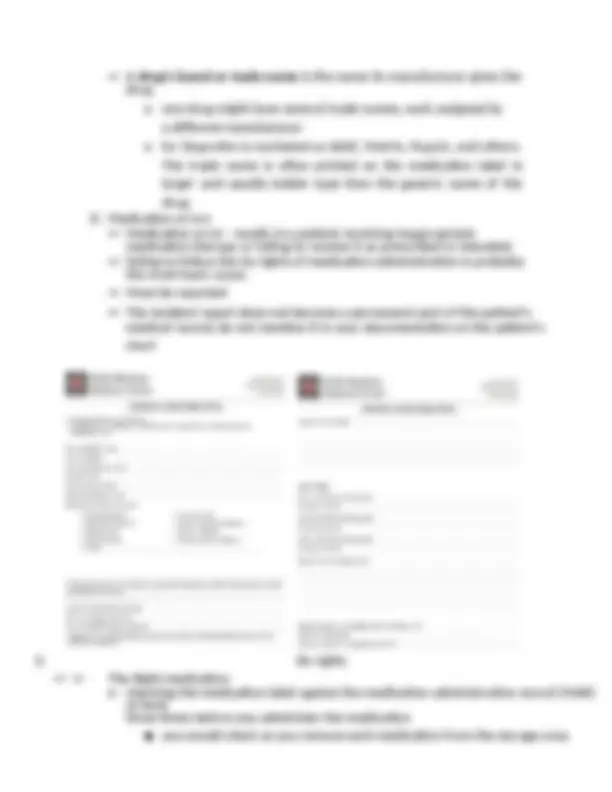
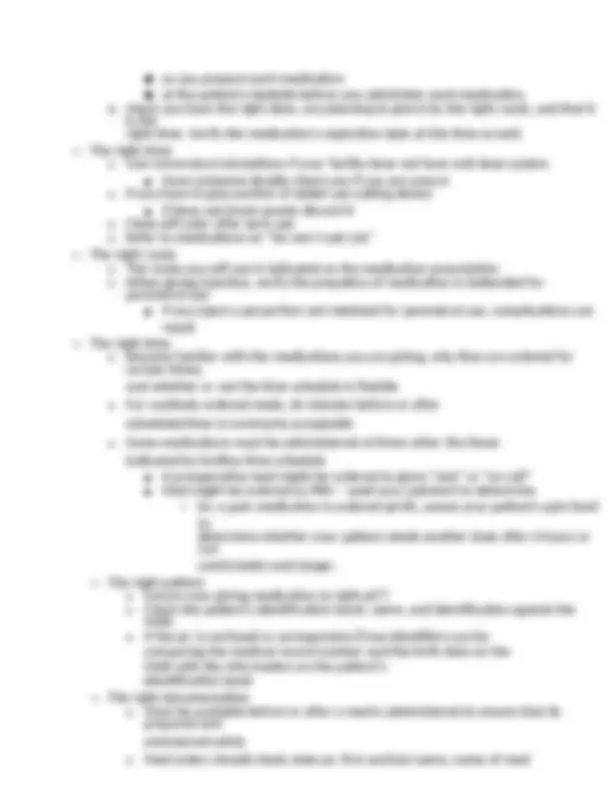
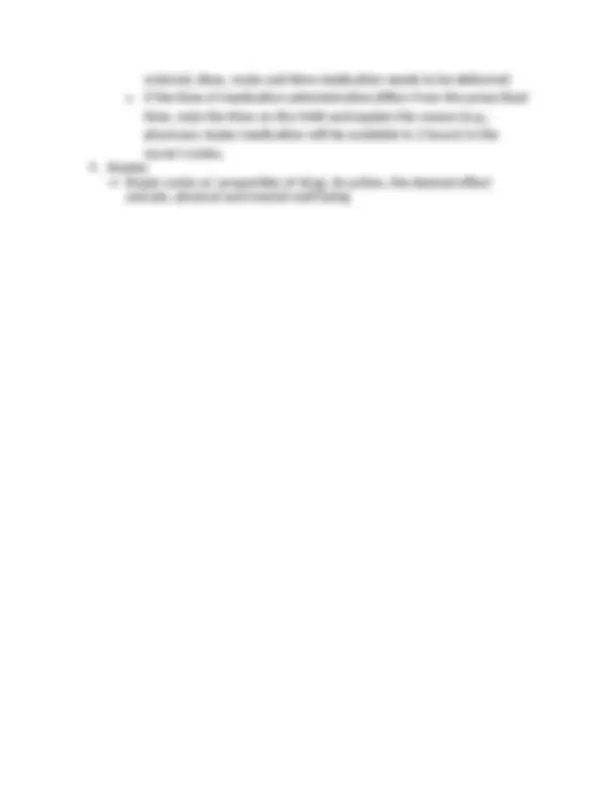
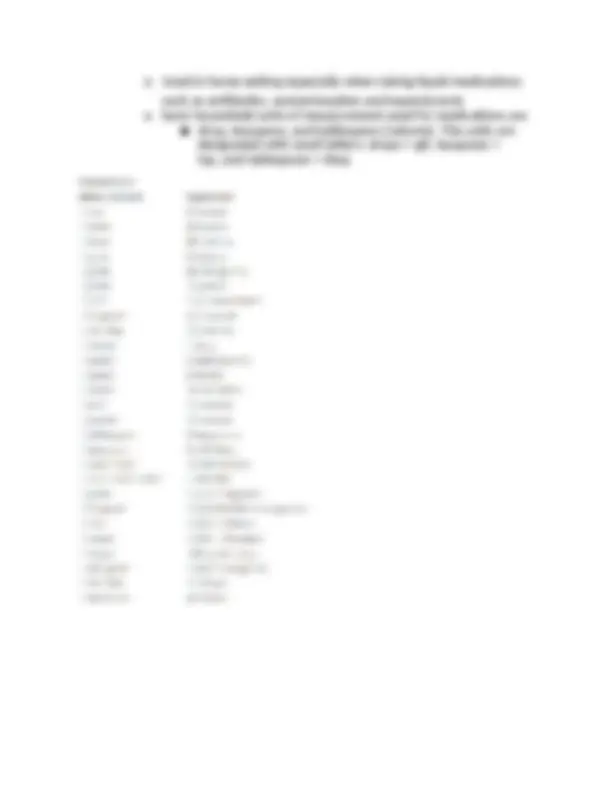
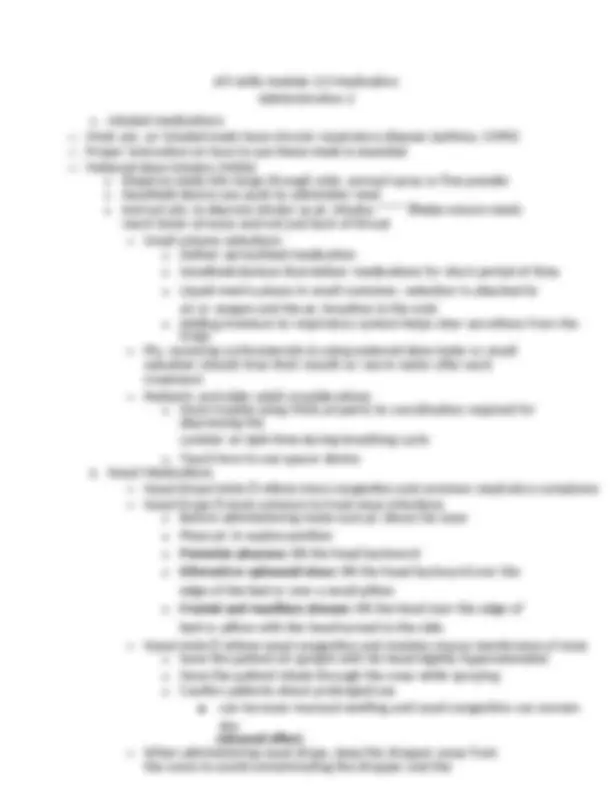

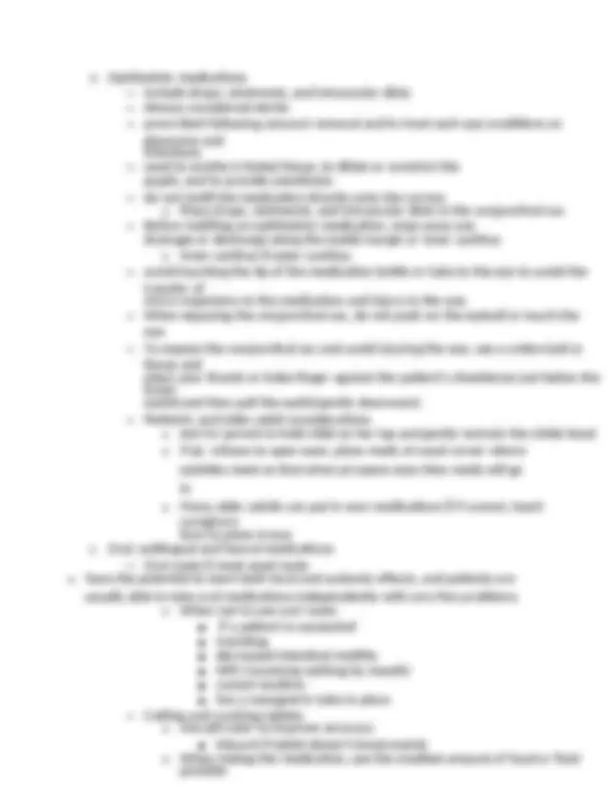
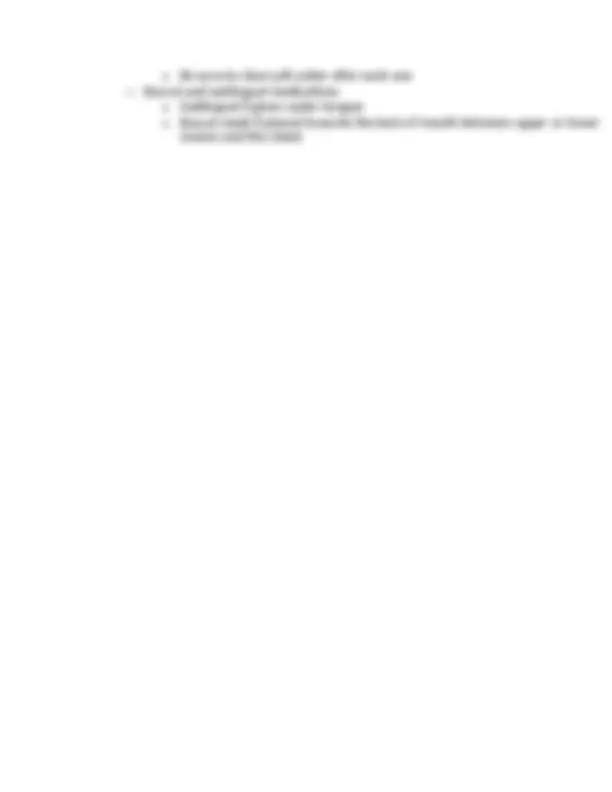
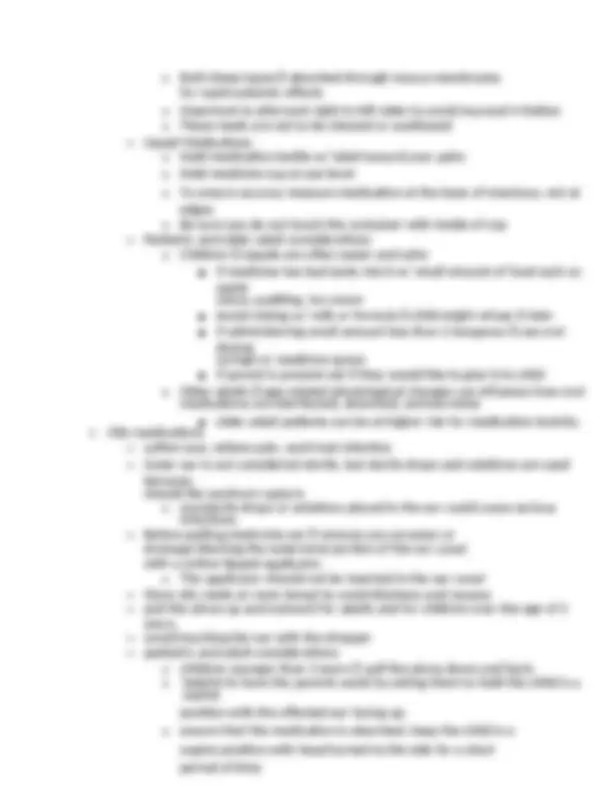
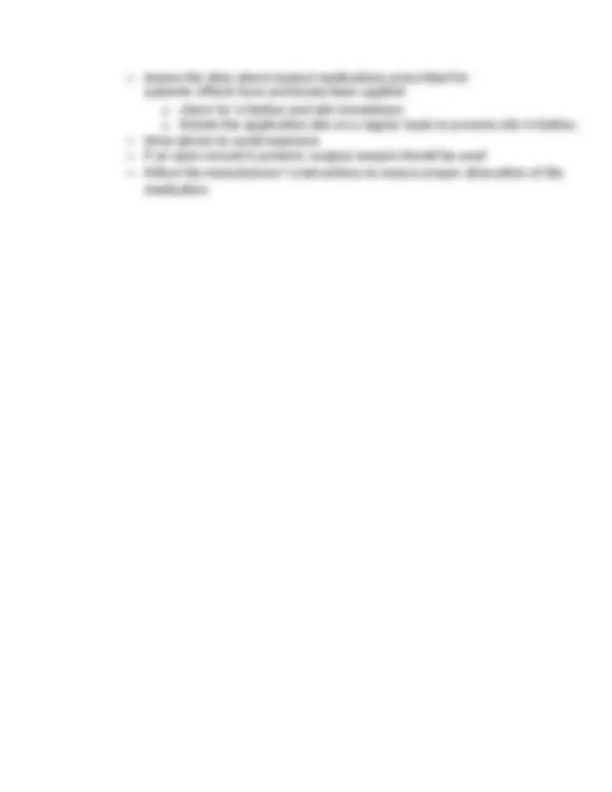


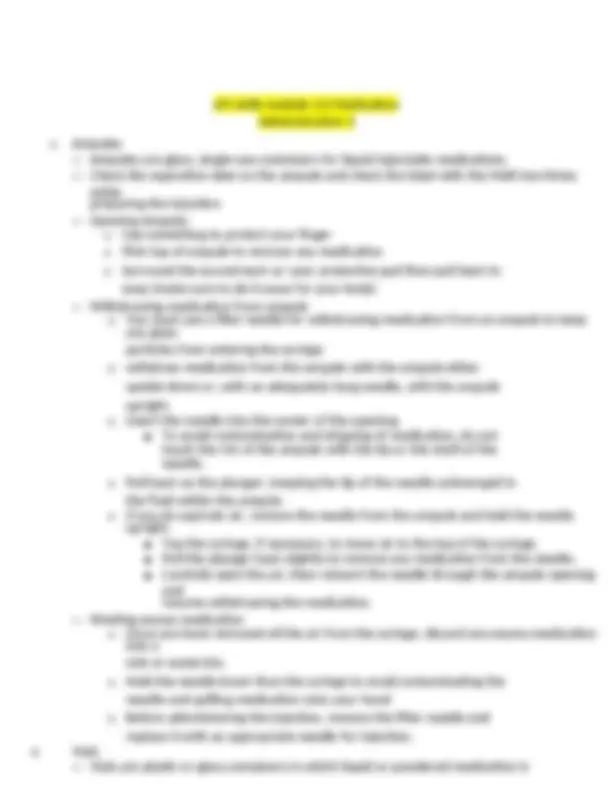
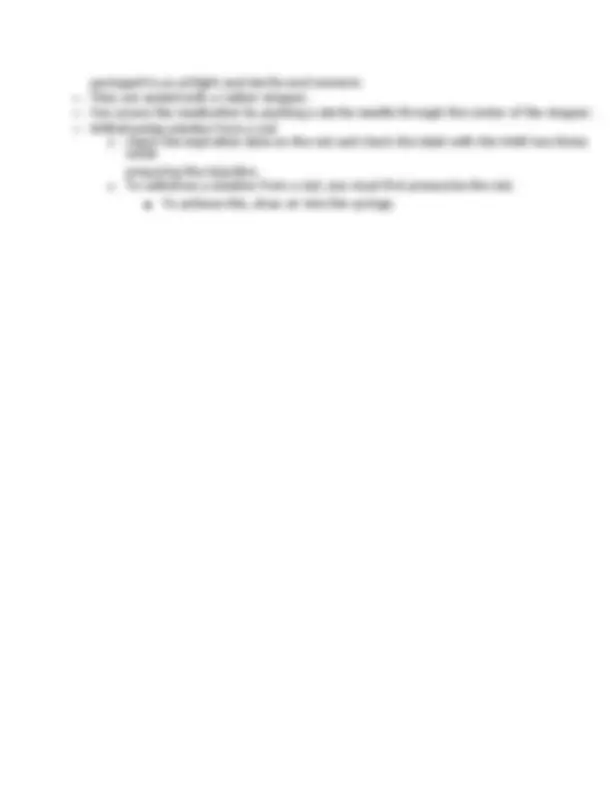
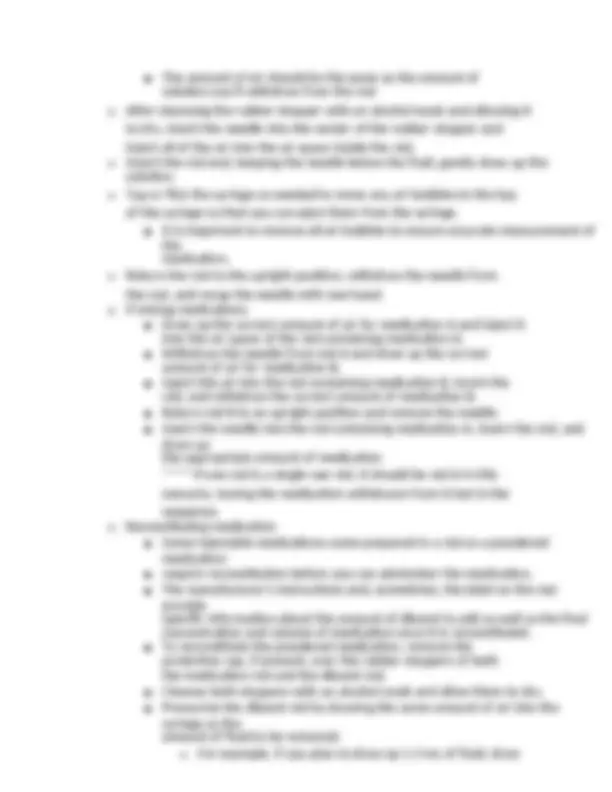
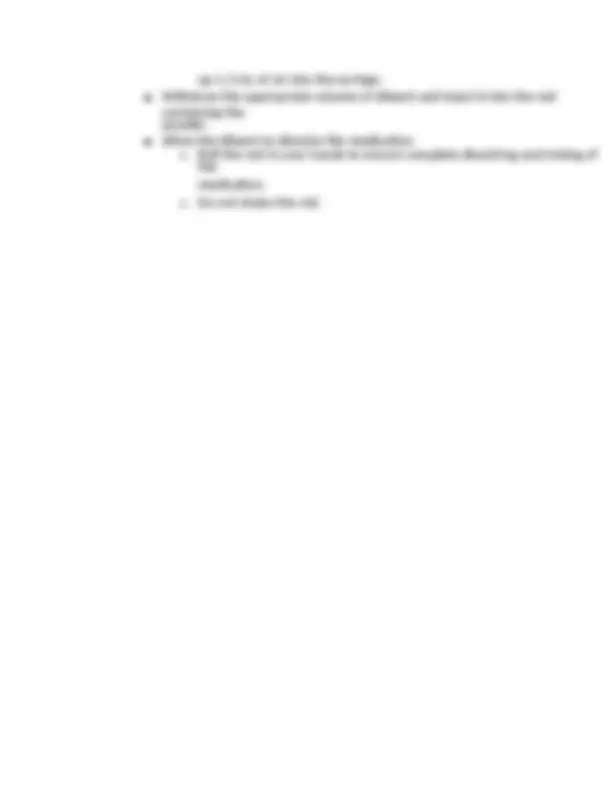
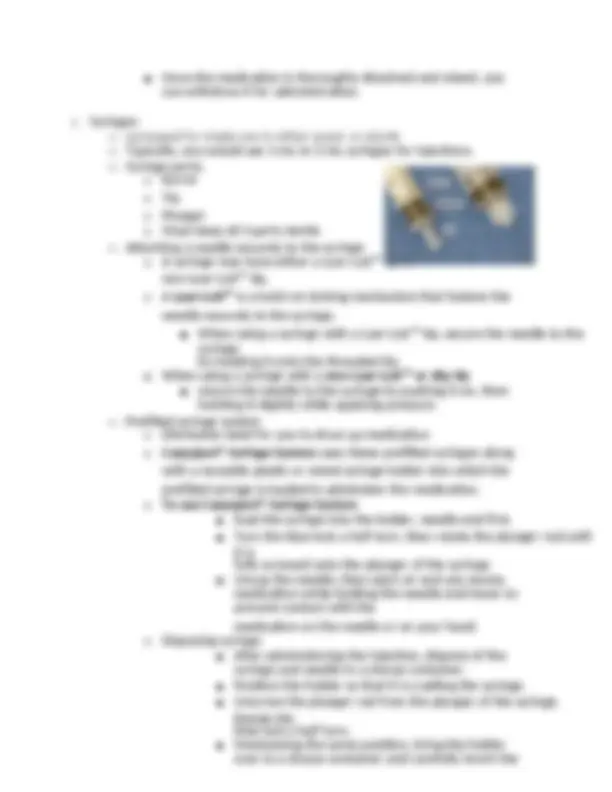

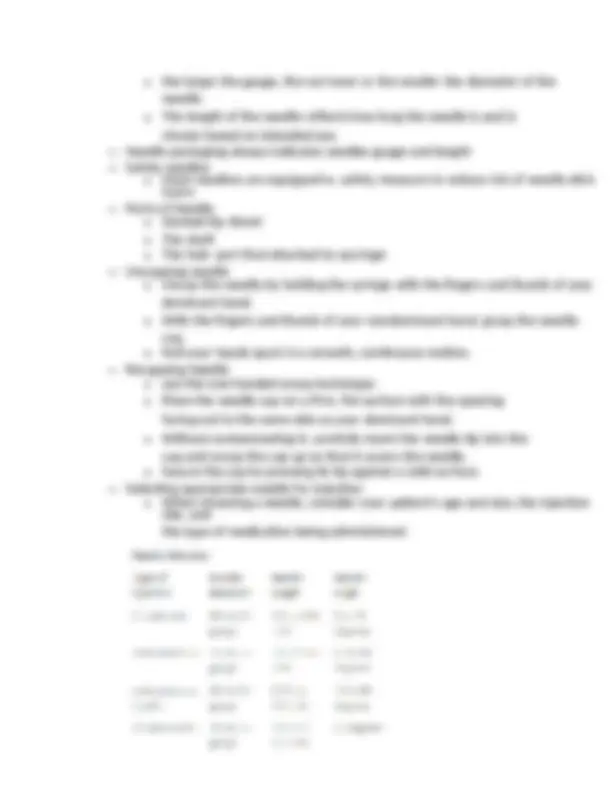

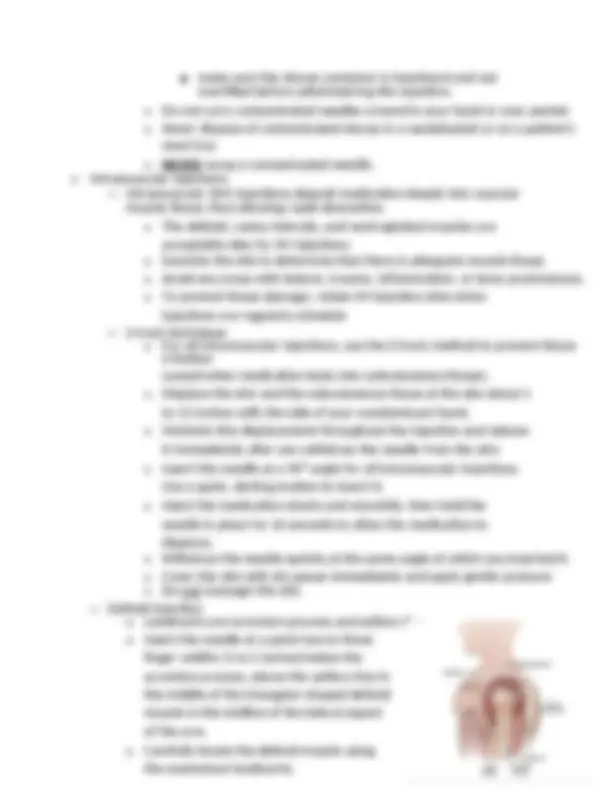
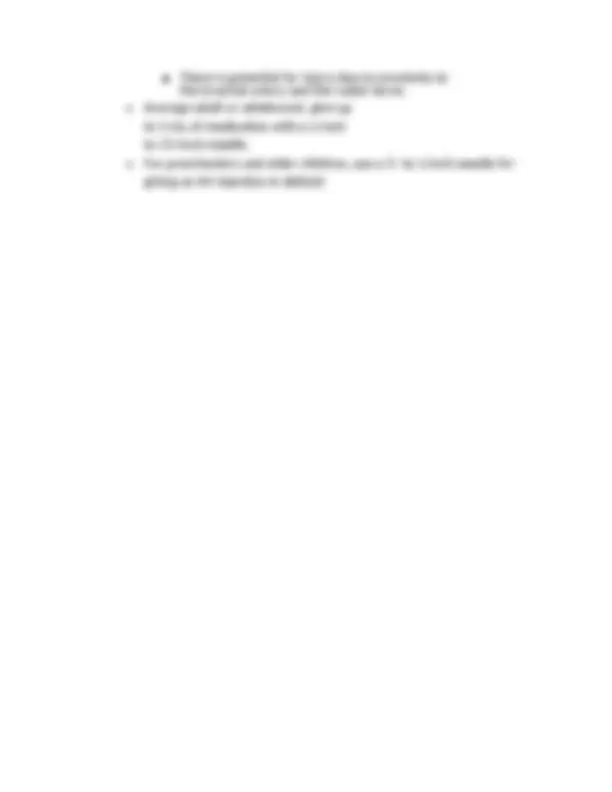
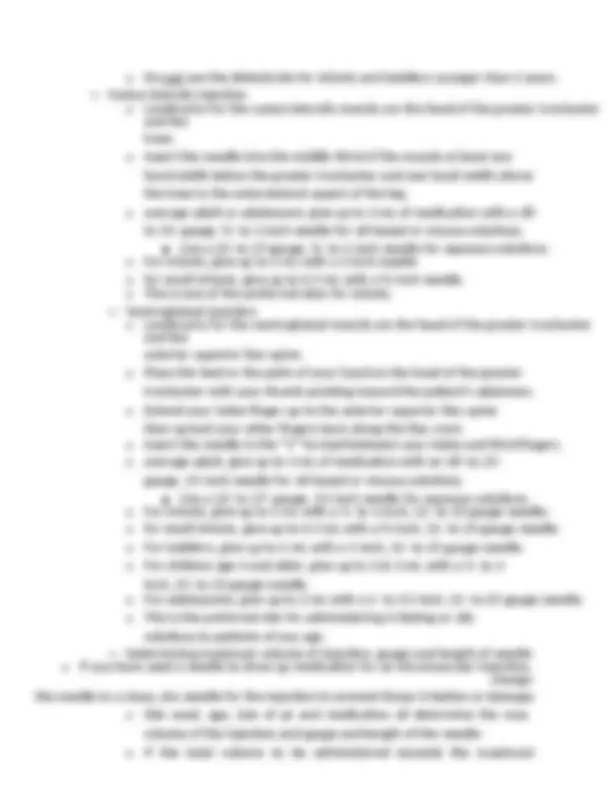

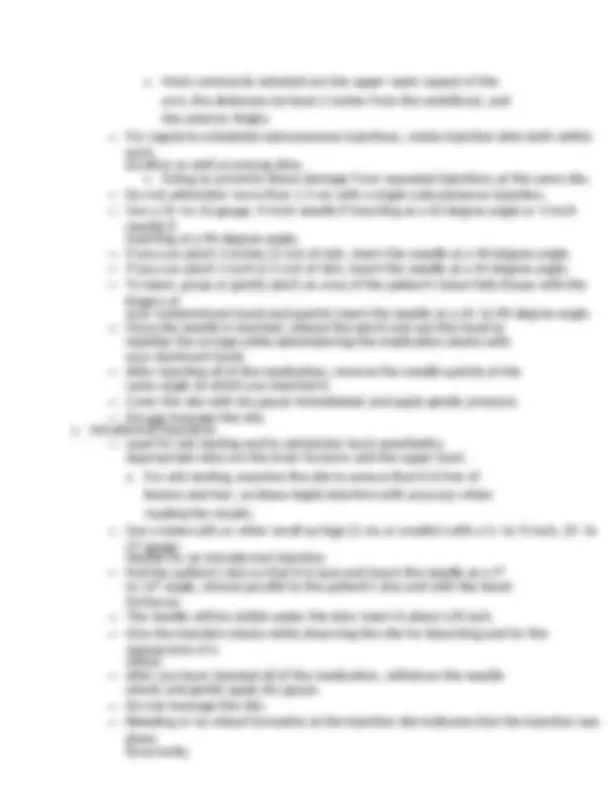
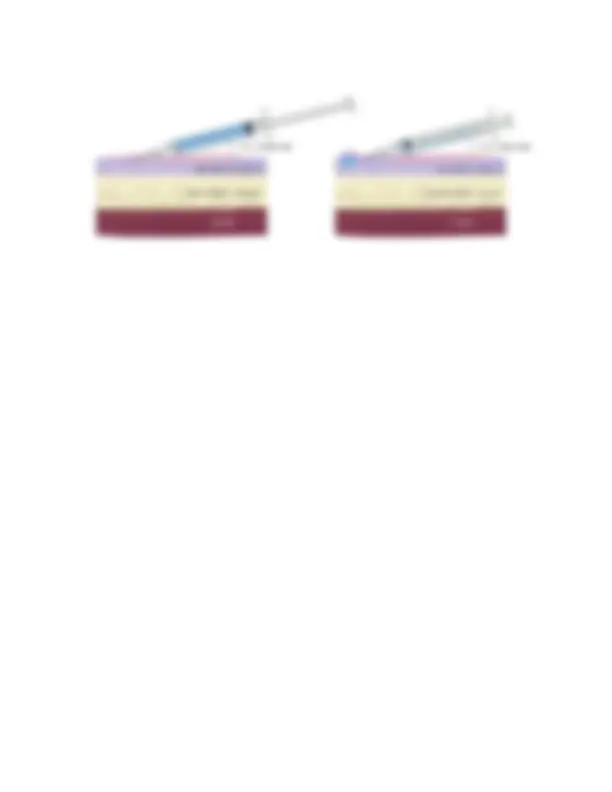


Study with the several resources on Docsity

Earn points by helping other students or get them with a premium plan


Prepare for your exams
Study with the several resources on Docsity

Earn points to download
Earn points by helping other students or get them with a premium plan
Community
Ask the community for help and clear up your study doubts
Discover the best universities in your country according to Docsity users
Free resources
Download our free guides on studying techniques, anxiety management strategies, and thesis advice from Docsity tutors
ATI Skills module 2.0 Medication Administration 1 Notes
Typology: Exams
1 / 34

This page cannot be seen from the preview
Don't miss anything!



























A. Drug Calculations and Conversions ⇨ Preform drug calculation using dimensional analysis, ratio and proportion or “desired over have” method ⇨ Dimensional analysis: x = Quality x desired Have ⇨ Ration and proportion ⇨ Desire over have method
B. Drug tolerance and dependence ⇨ Drug Tolerance to a drug develops as a patient’s physiological response to the medication decreases after repeated administration o Pts who have taken same meds or chemically related substance for period of time o Results in having to take higher doses to produce desired effect o Tolerance prone drugs: opioids, nitrates, benzodiazepines and barbiturates o Usually takes a month or longer to develop ⇨ Drug Dependence can be either psychological or physical o Psychological dependence includes intense feelings of craving for a substance can be a factor in development of addiction o Physical dependence develops when a patient actually needs a drug physiologically to function ▪ If the patient stops taking the drug abruptly, withdrawal symptoms follow ▪ Ex: long-term use of hydrocodone for pain relief. ❖ If the patient stops taking an opioid abruptly, signs of withdrawal such as nausea, irritability, and insomnia may result. ❖ As with tolerance, dependence takes a considerable period to develop. C. Generic and brand Names ⇨ generic name of a drug is its noncommercial name o often you will see the generic name printed on a drug label in small type, sometimes in parentheses, under the brand name o contain the same active ingredient in the same dosage as the brand- name drug and treat problems with the same effectiveness as the brand-name drug. o An exception is that a few drugs, such as phenytoin, may have different absorption rates ▪ could make a difference if a patient changed from one brand or generic formulation to another.
▪ as you prepare each medication ▪ at the patient’s bedside before you administer each medication. o check you have the right dose, are planning to give it by the right route, and that it is the right time. Verify the medication’s expiration date at this time as well. ⇨ The right dose o Use conversion/calculations if your facility dose not have enit dose system ▪ Have someone double check you if you are unsure o If you have to give portion of tablet use cutting device ▪ If does not break evenly discard it o Clean pill cuter after each use o Refer to medications on “Do not Crush List” ⇨ The right route o The route you will use is inidcated on the medication prescription o When giving injection, verify the prepation of medication is indtended for parenteral use ▪ If you inject a perpartion not intedned for parenteral use, complications can result ⇨ The right time o Become familiar with the medications you are giving, why they are ordered for certain times, and whether or not the time schedule is flexible o For routinely ordered meds, 30 minutes before or after scheduled time is commonly acceptable o Some medicaitons must be administered at times other tha those indicated by facilitys time schedule ▪ A preoperative med might be ordered to given “stat” or “on call” ▪ Med might be ordered as PRN – used your justment to determine
ordered, dose, route and time medication needs to be delivered o If the time of medication administration differs from the prescribed time, note the time on the MAR and explain the reason (e.g., pharmacy states medication will be available in 2 hours) in the nurse’s notes. F. Routes ⇨ Route varies w/ properities of drug, its action, the desired effect and pts. physical and mental well being
o uses Roman numerals and fractions o the abbreviation or symbol for the unit of measurement precedes the quantity. ⇨ Household system rules
o Used in home setting especially when taking liquid medications such as antibiotics, acetaminophen and expectorants o basic household units of measurement used for medications are ▪ drop, teaspoon, and tablespoon (volume). The units are designated with small letters: drops = gtt, teaspoon = tsp, and tablespoon = tbsp.
medication. C. Nasogastric medications ⇨ Pts. who have NG tube or other enteral tube are commonly given meds through tube ⇨ If meds are not available in liquid form crush it or open capsule and empty powder and disolve into sterile water
⇨ Do not administer sustained release, chewable, long acting or enterc coated tables through NG or enteral tube ⇨ Place pt. in high fowlers position and verify placement of tube in stomach o Aspirate a small amount of gastric contents through the NG or enteral tube with a syringe and then check the pH of the gastric contents while observing the color and appearance of the gastric or intestinal contents. ⇨ Check gastric residual o Connect a syringe, usually a 60-mL syringe, to the end of the nasogastric or enteral tube, then pull back evenly and gently on the syringe to aspirate contents o Return gastric contents to the stomach. o If the aspirate is greater than 100 mL, follow the agency policy about returning contents to the stomach and administering medications. o Flush with 15 mL of sterile water ⇨ If the patient is receiving a continuous feeding, do not mix the medications in the enteral feeding solution. o Instead, stop the feeding for 30 minutes, give the medications, flush the tube with 15 to 30 mL (5 to 10 mL for pediatric patients) of sterile water and then resume the feeding after at least 30 minutes ⇨ After you administer medications, keep the head of the patient’s bed elevated for at least 1 hour. ⇨ When administering medication through an NG or enteral tube, be sure to check your agency’s policy about stopping and resuming feedings before and after administering medications. ⇨ To keep an NG or enteral tube from becoming occluded o flush it w/ at least 15 to 30 mL (5 to 10 mL for pediatric patients) of sterile water before and after administering each medication o flush w/ 15 to 30 mL (5 to 10 mL for pediatric patients) after you have given all the patient’s medications. ⇨ If Ng or enteral tube does become occluded o First step: irrigate it gently w. appropriate flush solution
D. Ophthalmic medications ⇨ include drops, ointments, and intraocular disks ⇨ Always considered sterile ⇨ prescribed following cataract removal and to treat such eye conditions as glaucoma and infections. ⇨ used to soothe irritated tissue, to dilate or constrict the pupils, and to provide anesthesia ⇨ do not instill the medication directly onto the cornea o Place drops, ointments, and intraocular disks in the conjunctival sac ⇨ Before instilling an ophthalmic medication, wipe away any drainage or discharge along the eyelid margin or inner canthus o inner canthus outer canthus. ⇨ avoid touching the tip of the medication bottle or tube to the eye to avoid the transfer of micro-organisms to the medication and injury to the eye. ⇨ When exposing the conjunctival sac, do not push on the eyeball or touch the eye. ⇨ To expose the conjunctival sac and avoid injuring the eye, use a cotton ball or tissue and place your thumb or index finger against the patient’s cheekbone just below the lower eyelid and then pull the eyelid gently downward. ⇨ Pediatric and older adult considerations o Ask for parent to hold child on her lap and gently restrain the childs head o If pt. refuses to open eyes, place meds at nasal corner where eyelides meet so that when pt opens eyes then meds will go in o Many older adults can put in own medications if cannot, teach caregivers how to place in eye E. Oral, sublingual and buccal medications ⇨ Oral route most used route o have the potential to exert both local and systemic effects, and patients are usually able to take oral medications independently with very few problems. o When not to use oral route: ▪ If a patient is nauseated ▪ Vomiting ▪ decreased intestinal motility ▪ NPO (receiving nothing by mouth) ▪ cannot swallow ▪ has a nasogastric tube in place ⇨ Cutting and crushing tablets o Use pill cuter to improve accuracy ▪ Discard if tablet doesn’t break evenly o When mixing the medication, use the smallest amount of food or fluid possible
o Be sure to clean pill cutter after each use ⇨ Buccal and sublingual medications o Sublingual given under tongue o Buccal meds placed towards the back of mouth between upper or lower molars and the cheek
▪ ensures medication reaches all area of ear canal o most older adults can admister otic meds themselves ▪ teach caregivers how to properly adminster medications G. Rectal Medications ⇨ Local effect on the gastrointestinal mucosa to promote defecation ⇨ Systemic effects relieving nausea, providing analgesia, or reducing fever ⇨ Should never be used on pts. who had rectal surgery or active rectal bleeding
⇨ Rectal suppositories are bullet-shaped and individually packaged. o refrigerated to keep them from melting o A suppository inserted into the rectum melts as a result of the patient’s body temperature and is thus distributed to rectal tissue o should not be cut in half to divide the dose o Most patients prefer inserting rectal medication themselves. o For patients who cannot self-administer the medication ▪ don gloves ▪ then instill the medication by placing it past the internal anal sphincter and against the rectal mucosa ▪ avoid insertion into feces. o Have the patient remain in left lateral or left Sims’ position for approximately 5 minutes afterward to ensure absorption of the medication. o Lubricate the rounded end of the suppository with a water- soluble lubricant before insertion. o Instruct the patient to take slow, deep breaths through the mouth and to try to relax the anal sphincter. ▪ Doing this minimizes the discomfort of the insertion. o Pediatric and older adult considerations ▪ Pediatric: ⇨ Used often to reduce fever, to relieve nausea and vomiting, to provide analgesia, and sometimes to relieve constipation ⇨ Hold the child’s buttocks together gently 5 to 10 minutes to keep the suppository in place. ▪ Older adults: ⇨ might also have difficulty keeping the suppository in place due to a loss of sphincter control ⇨ might also have to hold the buttocks together gently so that the medication can dissolve and be absorbe ⇨ teach pts. who are inserting suppositories themselves about infection control techniques H. Topical Medications ⇨ include lotions, creams, ointments, patches, and pastes ⇨ Lotions, ointments, and creams usually produce a local effect. ⇨ Transdermal medications, usually in the form of a patch, produce a systemic effect ⇨ Cleanse the area first by gently washing it with soap and water to remove previously applied medication and any debris
⇨ When using transdermal patches or nitroglycerin ointment o remove the previous dose before applying the new one to prevent an inadvertent overdose. ⇨ Nitroglycerin oitment o When meds are in form of cream, it usually requires for aookying particular length o Use measuring strips that comes w/ medication o Secure the measuring strip to the skin to allow it to absorb gradually. o Always label the patch or dressing with date, time, and initials. o Do not massage or rub the ointment into the skin as this can cause the medication to be absorbed too rapidly. o Document the removal of the patch or dressing and the location of the new patch or dressing in the MAR. o Make sure to wear gloves to avoid effect of medication ⇨ Older adult considerations o Take into consideration changes associated w. aging akin o Apply lotions and creams genly to avoid bruising and damaging skin o Remove patch slowly and carefully o Older pts tend to absord skin meds faster bc thinness of skin ▪ Teach older adults about their medication and signs of toxicity ▪ Emphazie removing a patch before applying a new one I. Vaginal medications ⇨ relieve discomfort, and alter the vagina’s pH to maintain normal flora ⇨ available as jellies, foams, creams, or suppositories ⇨ Medicated douches or irrigations are sometimes used ⇨ Vaginal suppositories o oval-shaped and individually packaged o should be refrigerated to keep them from melting o Inserted into the vagina melts as a result of the patient’s body temperature and is thus distributed to vaginal tissue. ⇨ After instillation, patients may want to wear a perineal pad to absorb any excess medication ⇨ For pts. who cannot insert themselves o don gloves and then o using either an applicator or your gloved finger, instill the medication. o Have the patient remain in a supine position for approximately 10 minutes afterward to ensure absorption of the medication. ⇨ Advise pts. to continue using the medication even if they are actively menstruating
⇨ Tell patients taking antifungal medications to abstain from sexual intercourse until they have completed the entire medication course and the infection has resolved